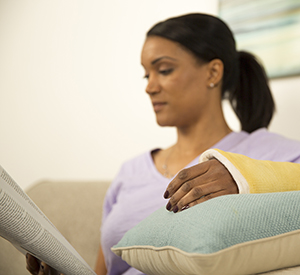A
B
C
D
E
F
G
H
I
J
K
L
M
N
O
P
Q
R
S
T
U
V
W
X
Y
Z
Topic IndexLibrary Index
Click a letter to see a list of conditions beginning with that letter.
Click 'Topic Index' to return to the index for the current topic.
Click 'Library Index' to return to the listing of all topics.
After Hand Surgery
After surgery, the better you take care of yourself—especially your hand—the sooner it will heal. Follow your surgeon’s instructions. Try not to bump your hand, and don’t move or lift anything while you’re still wearing bandages, a splint, or a cast.
Care for your hand

-
Keep your hand raised above heart level as much as possible for the first several days after surgery. This helps reduce swelling and pain.
-
To help prevent infection and speed up healing, take care not to get your cast or bandages wet.
Relieve pain as directed
Your surgeon may prescribe pain medicine or suggest you take an anti-inflammatory medicine. You might also be instructed to apply ice (or another cold source) to your hand. To make an ice pack, put ice cubes in a plastic bag that seals at the top. Wrap the bag in a clean, thin towel or cloth. Never put ice or an ice pack directly on the skin. The cold pack can be put right on the bandage, cast, or splint. Leave the cold source on your hand for as long as it’s comfortable. Do this several times a day for the first few days after surgery. It may take several minutes before you can feel the cold through the cast, splint, or bandages.
Follow up with your surgeon
During a follow-up visit after surgery, your surgeon will check your progress. The stitches, bandages, splint, or cast may be removed. A new cast or splint may be placed. If your hand has healed enough, your surgeon may prescribe exercises.
Do prescribed hand exercises
Your surgeon may advise that you do exercises. These may be done under the guidance of a physical or occupational therapist. The exercises strengthen your hand, help you regain flexibility, and restore correct function. Do the exercises as advised.
Call your surgeon if you have...
-
A fever of 100.4°F ( 38.0°C ) or higher, or as advised by your healthcare provider
-
Shaking chills
-
Side effects from your medicine, such as prolonged nausea or vomiting
-
A wet or loose bandage, or a bandage that is too tight
-
Excessive bleeding
-
Increased swelling, pain, tingling, or numbness
-
Loss of ability to move fingers
-
Fingers turn blue or cold
-
Signs of infection (such as drainage, warmth, or redness) at the incision site
Online Medical Reviewer:
Raymond Turley Jr PA-C
Online Medical Reviewer:
Rita Sather RN
Online Medical Reviewer:
Thomas N Joseph MD
Date Last Reviewed:
4/1/2024
© 2000-2025 The StayWell Company, LLC. All rights reserved. This information is not intended as a substitute for professional medical care. Always follow your healthcare professional's instructions.